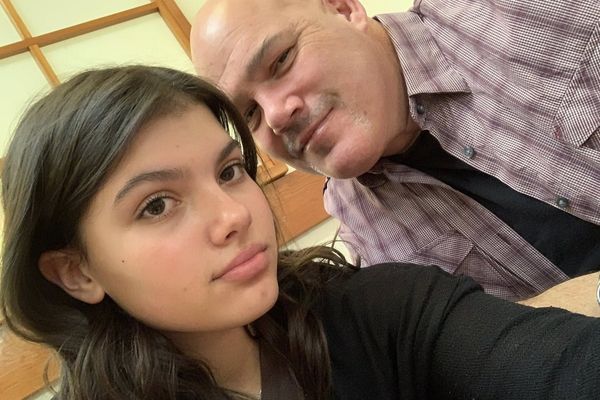
Among the paintings that Nusreldin Eldouma left behind when he fled Sudan is a watercolour portrait showing a Sufi sage, a popular figure from Sudanese folklore. Painted last year – just before Sudan was dragged into war after a power struggle between two factions of the country’s military – it shows the 17th-century sheikh Farah wad Taktook, an icon of peace, says Eldouma. Now he only has photographs to show, the canvases that are his life’s work left behind in the ruins of the city of Khartoum.
Photographs of Nusreldin Eldouma’s work displayed at 32° East (above) and his watercolour of a Sufi man, entitled Inner Peace (below; image courtesy of the artist)
“I like this painting because the character pursues simplicity and inner peace that appears in the features of his smiling face,” says Eldouma, one of four Sudanese artists now in exile in Uganda who recently completed a three-month residency at 32° East, an arts centre in the capital, Kampala.
The centre, which gave the artists accommodation, an allowance and materials, organises Kampala’s long-running public art festival, KLA ART, in August.
The sheikh’s peaceful demeanour is, says Eldouma, 55, in contrast to the current state of affairs in Sudan, where continuing hostility between the two warring sides has contributed to a cycle of violence that is pushing millions to the brink of famine.
A painting by Nusreldin Eldouma
Eldouma was caught up in the erupting civil war in Khartoum on 15 April 2023, his studio in the Imitidad Nasser neighbourhood just a street away from the airport, which was the site of clashes between the Sudanese Armed Forces (SAF), controlled by Gen Abdel Fattah al-Burhan, and the paramilitary Rapid Support Forces (RSF), led by Gen Mohamed Hamdan Dagalo (known as Hemedti).
“It is worse than a nightmare to wake up in the morning and your utmost goal is to save yourself from stray bullets, not to mention thinking even for a moment about your art, the fruits of your effort,” Eldouma says.
One of the pieces muralist and textile artist Tanzil Abdallah Adam made using thread during her residency at the Kampala arts space
As the violence shut health clinics, Eldouma’s brother died, unable to access the kidney dialysis treatment he depended on.
One of Tanzil Abdallah Adam’s designs
Also part of the 32° East residency, Tanzil Abdallah Adam was creating street art in public spaces in her home town of El Fasher, in west Sudan, but that was before the conflict began.
“Everything was going well. My career with the UN was promising, my art was prospering and I was surrounded by my loved ones,” she says. “Then the war happened and on the first day, eight of my colleagues and relatives died.”
During her residency Adam has been working with thread, incorporating crochet into her work.
Above and below: photographs by Mohammed Altaj hang on the gallery’s walls
Another artist taking part in residency is Mohammed Altaj, a film-maker and photographer, who was woken by a huge explosion on the first night of the conflict.
“As Sudanese, we are used to that,” he says, remembering the 2019 Khartoum massacre, the 2021 military coup and “all the terrible life-changing events that happened while we were asleep.”
Altaj has worked as a journalist in Khartoum and says there has been a “deliberate destruction and looting of media organisations” since the conflict began.
“This is directly affecting content creators and photographers,” he says. “Working in the media could expose one to the danger of being accused of espionage, treason or collaboration with either side.” He used his residency to work on a photographic project that tells the story of Sudan.
Teesa Bahana, 32° East’s director, says: “While there is little we feel we can do to stop ongoing genocides, we saw how having spaces like these can be a small respite in the face of such horror.”
Tanzil Abdallah Adam chats with Nusreldin Eldouma (left); visitors meet with the artists at 32° East (right)
Eldouma left Sudan in October, after being arrested and interrogated multiple times by military intelligence over his links to the 2018 protests which ended Omar al-Bashir’s 30-year regime in Sudan. Here he has mainly focused on drawing from life in the “charming city” of Kampala. He is “fascinated by its daily life and its picturesque natural landscapes of hills, waterfalls, means of transport and survival”.
“My artworks have been inspired by such beauty,” he says. “It is very important to immortalise such bright moments that fall between the rubble of life’s pressure.”
A painting by Nusreldin Eldouma of a woman barbecuing food on a street stall







